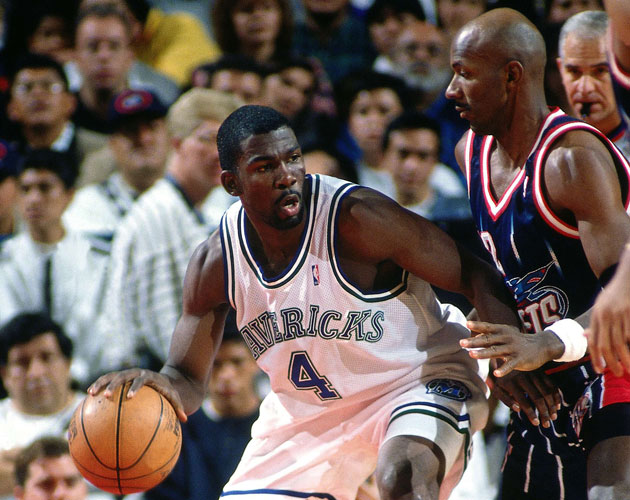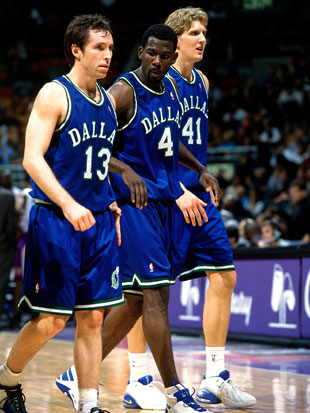
The last image we had of Michael Finley as an NBA pro came during the 2009-10 season, when Finley could barely get off the bench for the Boston Celtics on their drive to the Finals, following a disastrous half-season spent with the San Antonio Spurs. The game, we thought at the time, had passed the former All-Star by.
So when word comes out of Dallas that Finley wants to attempt to make a comeback with either the Dallas Mavericks (a team he currently works for, in the franchise's front office) or whatever other NBA squad will have him, we start off a little unenthused. He didn't look that great, last we left him, so how are things going to be some two and a half years later?
Then we go back and look at Finley's stats from the tail-end of his career, hopefully representative (in a diminished state, perhaps) what we could expect from Fin this time around … and things actually aren't that bad. We'll get to that in a second. First, the news from ESPN's Marc Stein:
Finley has since shaken that injury and, through longtime agent Henry Thomas, is pitching himself to teams as a capable shooter off the bench and mentor to young players.
He has been determined to carve out one more playing niche after a lengthy recovery from ankle surgery during the 2010 offseason complicated his efforts to find a job in 2010-11. Finley then flirted with making a comeback in the D-League last season -- which is a path veteran players have increasingly used to get on the NBA radar -- but ultimately decided against it.
Sources say Finley has been encouraged by the positive impact Rasheed Wallace has made in New York after coming out of retirement -- as well as Jerry Stackhouse's recent move to Brooklyn and Antonio McDyess' reported desire to restart his career -- because he has privately believed for months he could have a similar effect on a team's locker room.
Both Rasheed, Stackhouse, and McDyess were selected in the legendary 1995 NBA draft class. Of course, so were Ed O'Bannon, and Jason Caffey — the player Finley's hometown Bulls drafted ahead of Fin because they needed a rebounder and didn't like employing Chicago-born players back then. As stories go, Wallace's return and Stackhouse's continued employment are pretty cool things.
Of course, Rasheed Wallace takes eight — eight! — three-pointers for every 36 minutes that he's on the court, in spite of only making 28 percent of them. He's been hilarious thus far, and the New York Knicks are currently one of the best teams in the NBA, but Rasheed hasn't had as much to do with that as the headlines would leave you to believe.
With Stackhouse, we also have to understand that he hasn't undergone a significant surgery on his ankle, as is the case with Finley. He's half a year younger than Fin, and has been in NBA locker rooms receiving NBA-styled treatment (save for brief stints working at NBA TV) while Michael has been away.
And Finley, based on recollection alone, looked a little slow afoot during his last season in 2009-10. And that was at the relatively young age of 36. By the end, he was down to making just a quarter of his shots in the postseason during Boston's run to the Finals that year.
Then again, he shot 46 percent from behind the arc in 21 games with the C's during the regular season. And though that percentage dips to 31 percent as we look back to his first 25 games in 2009-10 with the San Antonio Spurs, Finley did shoot a very nice 39.2 percent from behind the arc from 2003 until that final season. If he can keep that up, from the corner, at a reasonable price for a team that could use the spacing?
Can't believe we're saying this … but why not?
 The leadership aspect has to be a part of the package, as well. Finley routinely led the NBA in minutes played during his prime years, taking care of his body and toiling away for teams that were awful-to-brilliant with nary a peep. The sheer amount of legends he's played with — Charles Barkley, Sam Cassell, Kevin Johnson, Steve Nash, Dirk Nowitzi, Tim Duncan, Kevin Garnett, Paul Pierce, Ray Allen, Hot Rod Williams, Evan Eschmeyer — it's staggering.
The leadership aspect has to be a part of the package, as well. Finley routinely led the NBA in minutes played during his prime years, taking care of his body and toiling away for teams that were awful-to-brilliant with nary a peep. The sheer amount of legends he's played with — Charles Barkley, Sam Cassell, Kevin Johnson, Steve Nash, Dirk Nowitzi, Tim Duncan, Kevin Garnett, Paul Pierce, Ray Allen, Hot Rod Williams, Evan Eschmeyer — it's staggering.
If Finley is healthy, a reasonable facsimile of his final year in Boston — below average, end of the bench, but a floor-spacer — can help an NBA team. Guards generally don't return to form as well as big men in this league, and we're well aware of Fin's combined 41,093 regular and postseason minutes, but as a 10th or 11th man in a league still featuring DeShawn Stevenson for some reason, Finley can help.
No comments:
Post a Comment